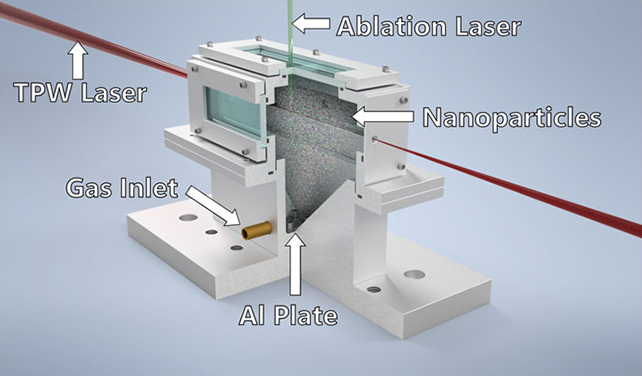Products You May Like
Particle accelerators are hugely useful in scientific research, but – like the Large Hadron Collider (LHC) – usually take up vast amounts of room. A remarkable new system developed at the University of Texas in Austin could change this.
In experiments, researchers were able to use their particle accelerator to generate an electron beam with an energy of 10 billion electron volts (10 GeV) in a chamber measuring just 10 centimeters (4 inches).
The complete instrument measures 20 meters (66 feet) from end to end. In comparison, other particle accelerators that can generate 10 GeV beams are some 3 kilometers (almost 2 miles) in length – about 150 times as long.
Key to reducing the size of the system so significantly was combining high-energy, ultra-short laser pulses with helium gas dusted with aluminum nanoparticles.
These particles boost the energy of electrons stripped from the nanoparticles by the laser, which are pushed to the edges of the laser where they ride the laser-induced plasma waves like surfers on the wake of a boat on a lake.
Whereas the strength of these waves would normally be overwhelming – in the same way that jet skis overpower the waves left behind by boats – the nanoparticles offer more stability and allow the system to be shrunk down.

“In our accelerator, the equivalent of jet skis are nanoparticles that release electrons at just the right point and just the right time, so they are all sitting there in the wave,” says physicist Bjorn Hegelich, from the University of Texas at Austin.
“We get a lot more electrons into the wave when and where we want them to be, rather than statistically distributed over the whole interaction, and that’s our secret sauce.”
This type of particle accelerator, using lasers to generate plasma waves, is called a wakefield laser accelerator. The team says their advanced version could be useful in studying semiconductors, in testing equipment for space, and in developing cancer therapies.
All this is possible because of the way these instruments accelerate electrons (hence the name) to high speeds, generating energetic waves of electromagnetic radiation such as X-rays that could be used to image molecular-scale processes.

The researchers are looking forward to developing the system further, but there’s still a lot about the interactions between electrons, lasers, and plasma that we don’t fully understand. In other words, there are plenty of exciting scientific discoveries ahead.
“Currently, we do not have a satisfactory model or experimental explanation for the generation of such high electron energies,” write the researchers in their published paper.
“Various theoretical scenarios are now under investigation and, if relevant, will be the subject of future publications.”
The research has been published in Matter and Radiation at Extremes.
